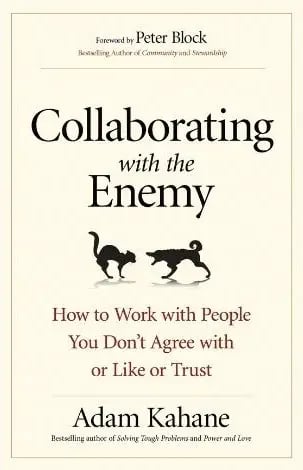
Collaborating with the Enemy
By Adam Kahane
The seed of this book was my observation of a pattern at the heart of many of Reos’ efforts to effect systemic change. On the one hand, our projects help people work together with others whom they see as different in terms of interests, sector, politics, perspective, class, race, gender, etc. They think that, in order to be able to make progress on a systemic challenge that matters to them, they must work with these others. On the other hand, they think that in order not to compromise what matters to them, they must not work with these others. So collaboration often seems both imperative and impossible—and the more we need it, the more difficult we find it.
But this conventional assumption is wrong. When we are working in complex situations with diverse others, collaboration cannot and need not be controlled.
This tension is crystallized in the two dictionary definitions of “collaboration.” It means simply “to work jointly with” but also “to cooperate traitorously with the enemy.” The word therefore evokes both a story of generous and inclusive progress, such as an energetic and creative work team (“We must all collaborate!”), and a story of degenerative and amoral villainy, as in France during World War II (“Death to collaborators!”).
I wondered how to understand and work with this tension.
The conclusion I came to in writing this book is that the reason such collaborations seem impossible is that we misunderstand collaboration. Our conventional understanding of collaboration is that it requires us all to be on the same team and headed in the same direction, to agree on what has to happen and be able to make sure this happens, and to get people to do what needs to be done. In other words, we assume that collaboration can and must be under control.
Unconventional, stretch collaboration abandons the assumption of control. It gives up unrealistic fantasies of harmony, certainty, and compliance, and embraces messy realities of discord, trial and error, and cocreation. Stretch collaboration enables us to get things done even in complex situations with people we don’t agree with or like or trust.
Stretch collaboration requires us to make three fundamental shifts in how we work.
First, in how we relate with our fellow collaborators, we must stretch away from focusing narrowly on the collective goals and harmony of our team, and move toward embracing both conflict and connection within and beyond the team.
Second, in how we advance our work, we must stretch away from insisting on clear agreements about the problem, the solution, and the plan, and move toward experimenting systematically with different perspectives and possibilities.
And third, in how we participate in our situation—in the role we play—we must stretch away from trying to change what other people are doing, and move toward entering fully into the action, willing to change ourselves.
Stretch collaboration is challenging because all three of these stretches require us to do the opposite of what seems natural. Rather than shrink away from complexity and conflict, we must plunge into it. Often this feels uncomfortable and frightening.
My colleagues and I are incorporating this new body of “stretch collaboration” theory and practice into Reos’ consulting and capacity building offerings. We look forward to engaging with you around this challenging core aspect of systemic change work.
Order your copy from Amazon, Indigo, Berrett-Koehler, or other booksellers.
About the Author
Adam is a leading organizer, designer and facilitator of processes through which business, government, and civil society leaders can work together to address such challenges. He has worked in more than fifty countries, in every part of the world, with executives and politicians, generals and guerrillas, civil servants and trade unionists, community activists and United Nations officials, clergy and artists.
He is a Member of the Order of Canada. In 2022 he was named a Schwab Foundation Social Innovation Thought Leader of the Year at the World Economic Forum in Davos.